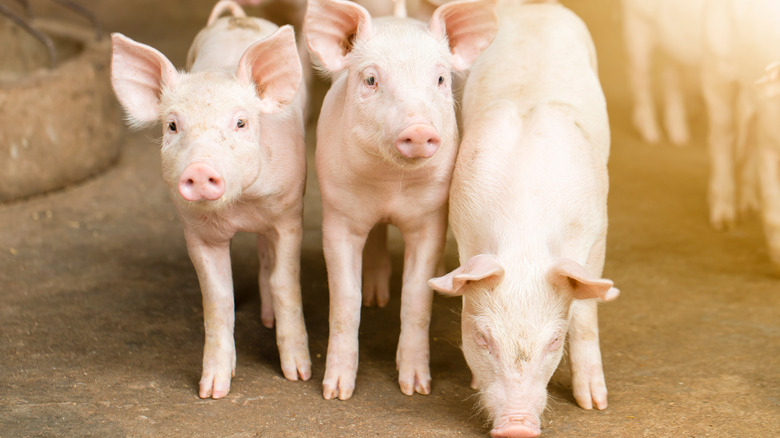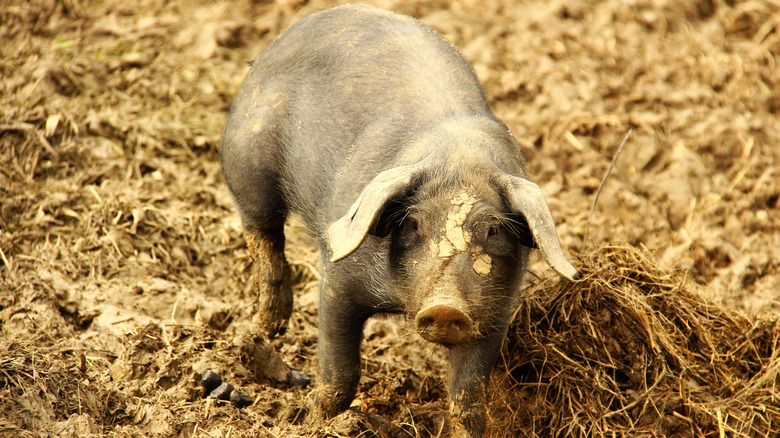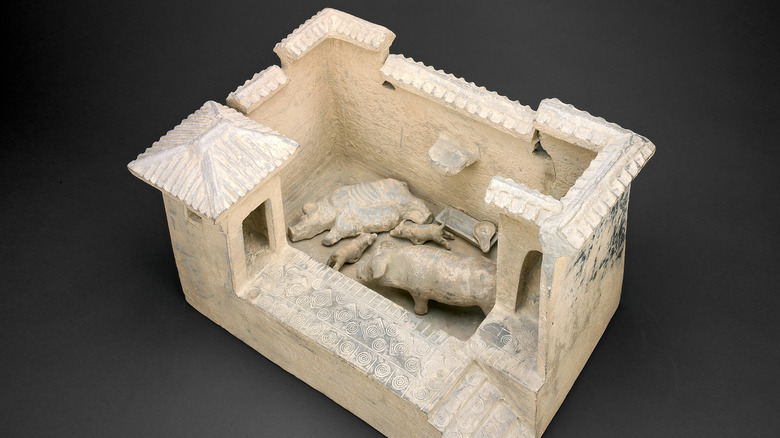The Truth About Pig Toilets In Ancient China
In ancient China, humans and pigs had a surprising symbiotic relationship that was as wholesome as it was ingenious. The Chinese character "ce," meaning "toilet" today, also meant "pigsty" in ancient Chinese, writes Dai Wangyun in Sixth Tone. According to Wangyun, this double meaning is a linguistic remnant of the ancient Chinese pig latrines, in which toilets and pigpens were part of the same building — for a good reason. Pig latrines prevented disease. Additionally, they made nutrient-rich compost that sustained agriculture throughout East Asia, says the University of Toledo's David J. Nemeth in the book "Ancestors for the Pigs: Pigs in Prehistory." Nemeth explains that the Chinese character for "toilet" represents the structure of a pig latrine. The ideogram for "pig" is enclosed by a pen-like square.
Pigs and humans worked together in ancient China to nourish crops, sustaining life for both species. In most ancient pig latrines, the pigs resided on a lower level, while stairs led humans to a lavatory above. Human waste traveled down from the latrine level to a pig trough below via a chute, explains Wangyun. Nemeth points out that the height of the human facilities aided in sanitation and protected latrine-goers from overly eager, sometimes aggressive, and hungry pigs.
Pig latrines served as an ancient composting method
In China, the benefits of pig latrines were — and in some rural places still are — numerous. Pigs consumed human waste as well as household scraps, making them living composters. Even further, pig latrines were excellent at disease prevention and smell reduction. Hungry pigs quickly consumed human waste. Their speed minimized contact with flies and rodents, significantly reducing the spread of germs, explains David J. Nemeth in "Ancestors for the Pigs: Pigs in Prehistory."
The pig manure was mostly free of odor, and the pigs' digestive tracts nearly eliminated disease and parasites, writes Nemeth. Farmers then used the cleaner, not-so-smelly manure as fertilizer for crops rich in nutrients such as nitrogen and potassium.
Privy pigs also aided in turning their byproducts into fertilizer by simply moving back and forth around the enclosure. According to Nemeth, their hooves' movements helped break down the manure, which farmers also enriched with grains. Once or twice a year, farmers harvested the rich fertilizer by emptying the pen of its contents and using it to nourish the crops. Pig latrines created a near-perfect symbiotic relationship between pigs and humans.
Even the dead request pig latrines
Pig latrines were so integral in ancient East Asia that people often hoped to use them in their afterlives (per Minneapolis Institute of Art). During the Han Dynasty (206 B.C. to A.D. 220), the middle and upper classes were often buried with items of symbols of the comfort, riches, and luxuries they hoped to enjoy in the afterlife. Clay models represented larger, less portable, objects like buildings, as Britannica notes. These models included fine dwellings and food-producing facilities like mills and granaries. Miniature pig latrines were often a part of these burial items, speaking to their importance in everyday life.
Archeologists have found pig figurines in Shandong tombs, writes David J. Nemeth in "Ancestors for the Pigs: Pigs in Prehistory." The tombs date back to the Neolithic era, 10,000-3,000 B.C. (Britannica). The ancient pig figurines hint at how important pigs have been in East Asia for thousands of years. In some areas of rural China, people still use pig latrines today, says Dai Wangyun in Sixth Tone. However, efforts to modernize sanitation across the country are replacing the thousands-year-old tradition of pig latrines.


